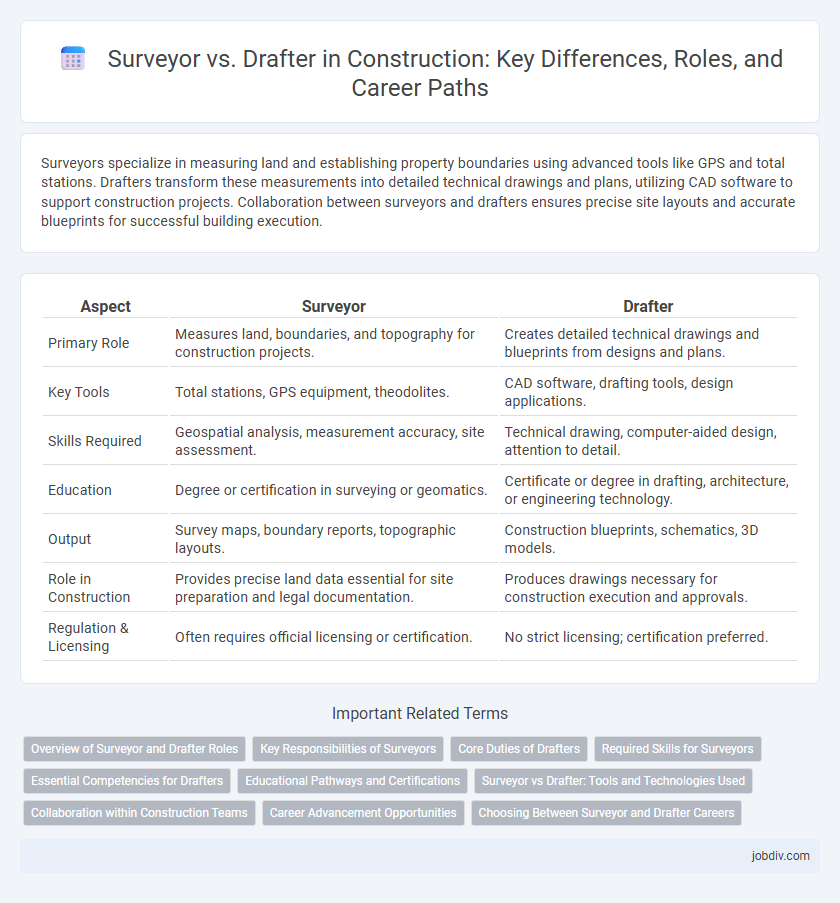Surveyors specialize in measuring land and establishing property boundaries using advanced tools like GPS and total stations. Drafters transform these measurements into detailed technical drawings and plans, utilizing CAD software to support construction projects. Collaboration between surveyors and drafters ensures precise site layouts and accurate blueprints for successful building execution.
Table of Comparison
| Aspect | Surveyor | Drafter |
|---|---|---|
| Primary Role | Measures land, boundaries, and topography for construction projects. | Creates detailed technical drawings and blueprints from designs and plans. |
| Key Tools | Total stations, GPS equipment, theodolites. | CAD software, drafting tools, design applications. |
| Skills Required | Geospatial analysis, measurement accuracy, site assessment. | Technical drawing, computer-aided design, attention to detail. |
| Education | Degree or certification in surveying or geomatics. | Certificate or degree in drafting, architecture, or engineering technology. |
| Output | Survey maps, boundary reports, topographic layouts. | Construction blueprints, schematics, 3D models. |
| Role in Construction | Provides precise land data essential for site preparation and legal documentation. | Produces drawings necessary for construction execution and approvals. |
| Regulation & Licensing | Often requires official licensing or certification. | No strict licensing; certification preferred. |
Overview of Surveyor and Drafter Roles
Surveyors measure land, establish property boundaries, and prepare site plans critical for construction projects, using tools like GPS, total stations, and GIS technology. Drafters translate these measurements and design specifications into detailed technical drawings and blueprints with software such as AutoCAD and Revit, guiding construction teams. Both roles collaborate to ensure accurate site layouts and construction documentation that meet engineering and architectural standards.
Key Responsibilities of Surveyors
Surveyors are responsible for measuring land boundaries, preparing site maps, and ensuring accuracy in topographic data for construction projects. They analyze terrain features, establish reference points, and provide critical data for architects and engineers to design structures. Surveyors also conduct risk assessments related to land conditions, enhancing compliance with regulatory standards.
Core Duties of Drafters
Drafters in construction create precise technical drawings and plans based on designs from architects and engineers, ensuring accurate representation for project execution. They utilize computer-aided design (CAD) software to draft detailed blueprints, layouts, and schematics, facilitating clear communication among construction teams. Their core duties include revising drawings to incorporate design changes and complying with industry standards, codes, and regulations to support efficient building processes.
Required Skills for Surveyors
Surveyors require strong analytical skills to accurately measure land and interpret geographic data, ensuring precise site assessments. Proficiency in using advanced surveying equipment such as GPS, total stations, and GIS software is essential for collecting and processing spatial information. Effective communication and teamwork abilities are crucial for collaborating with construction engineers, architects, and clients to deliver accurate project layouts and compliance with legal boundaries.
Essential Competencies for Drafters
Drafters require proficiency in computer-aided design (CAD) software, attention to detail, and the ability to interpret architectural and engineering specifications accurately. Strong spatial awareness and understanding of construction materials and methods are critical for producing precise technical drawings. Effective communication skills facilitate collaboration with engineers, architects, and construction teams to ensure project accuracy and compliance.
Educational Pathways and Certifications
Surveyors typically pursue a degree in geomatics, civil engineering, or surveying technology along with certifications such as the Certified Survey Technician (CST) or Professional Land Surveyor (PLS) license, emphasizing fieldwork and measurement accuracy. Drafters usually complete a diploma or associate degree in drafting, CAD technology, or architectural design and obtain certifications like Autodesk Certified Professional to master computer-aided design software for creating technical drawings. Both professions demand specialized education tailored to their roles, with surveyors focusing on land measurement and legal boundaries, while drafters emphasize precise visual representations for construction projects.
Surveyor vs Drafter: Tools and Technologies Used
Surveyors utilize advanced tools such as total stations, GPS receivers, and laser scanners to measure and map construction sites with high precision. Drafters rely on computer-aided design (CAD) software, 3D modeling programs, and digital drafting tables to convert survey data into detailed construction plans and blueprints. The integration of geographic information systems (GIS) enhances the accuracy of survey data, while parametric design tools improve the efficiency of drafting processes.
Collaboration within Construction Teams
Surveyors and drafters collaborate closely to ensure accurate site measurements translate into precise construction plans, enhancing project efficiency. Surveyors collect critical spatial data while drafters convert this information into detailed technical drawings, facilitating clear communication among architects, engineers, and builders. Effective collaboration between these professionals minimizes errors, streamlines workflows, and supports timely project completion in construction teams.
Career Advancement Opportunities
Surveyors with field expertise and certification opportunities can advance into project management and land development roles, leveraging their precise data collection skills. Drafters benefit from mastering advanced CAD software and gaining experience in building information modeling (BIM), which opens pathways to senior designer or BIM coordinator positions. Both careers require continuous skill development, but surveyors often have broader fieldwork and leadership advancement options within construction project teams.
Choosing Between Surveyor and Drafter Careers
Choosing between a surveyor and a drafter career depends on your skills and interests in construction projects. Surveyors specialize in measuring land and mapping precise property boundaries using GPS and geographic information systems (GIS), essential for site planning and legal documentation. Drafters focus on creating detailed technical drawings and blueprints using software like AutoCAD and Revit, supporting architects and engineers in visualizing construction designs.
Surveyor vs Drafter Infographic

 jobdiv.com
jobdiv.com